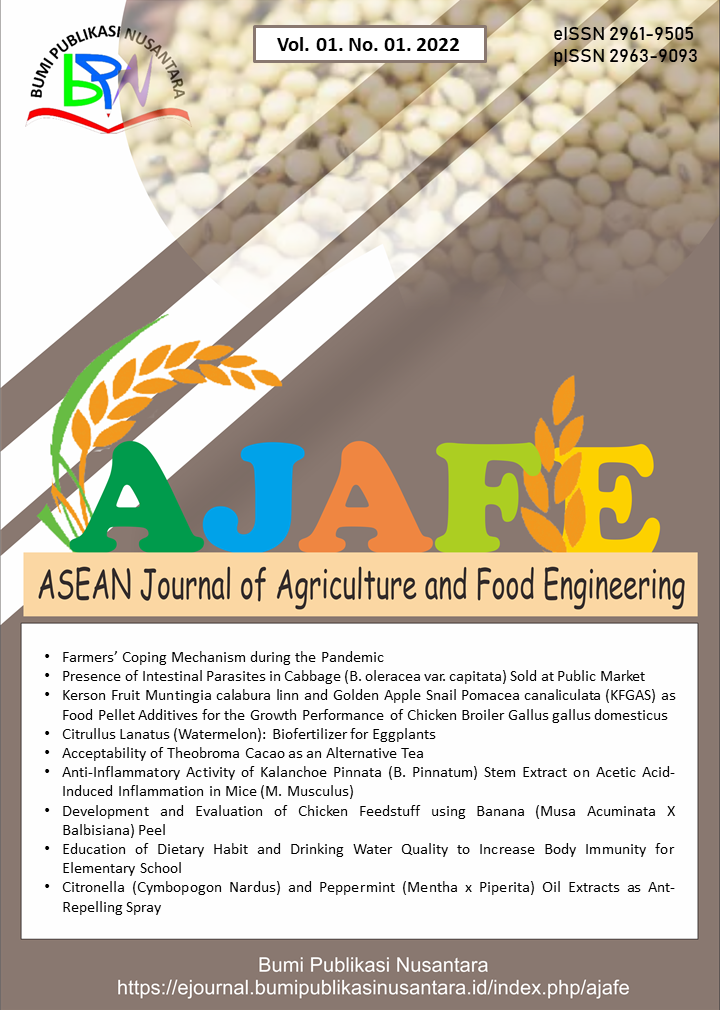Genetic Diversity of Orchids for Sustainable Floriculture: A Narrative Literature Review
 ), Suci Wulandari(2), Kurnia Dwi Ardiyant(3), Agil Faiqotul Iqbalia(4),
), Suci Wulandari(2), Kurnia Dwi Ardiyant(3), Agil Faiqotul Iqbalia(4),
(1) National Research and Innovation Agency
(2) National Research and Innovation Agency
(3) University of Jember
(4) University of Jember
 Corresponding Author
Corresponding Author
Abstract
Keywords
References
Ahmad, S., Chen, G., Huang, J., Yang, K., Hao, Y., Zhou, Y., Zhao, K., Lan, S., Liu, Z., and Peng, D. (2022). Beauty and the pathogens: A leaf-less control presents a better image of Cymbidium orchids defense strategy. Frontiers in Plant Science, 13, 1–13.
Axiotis E., Angelis A., Antoniadi L., Petrakis E. A., Skaltsounis L. A. S. (2022). Phytochemical analysis and dermo-cosmetic evaluation of Cymbidium sp. (Orchidaceae) cultivation by-products. Antioxidants, 11(101), 2–20.
Battistus, A., Klein, J., Costa, N., Guimaraes, V. ., and Hoffmann, V. (2014). Chemical control of Pilea microphylla in Catleya seedlings. Planta Daninha, 32(4), 801–807.
Chang, Y. Y., Chu, Y. W., Chen, C. W., Leu, W. M., Hsu, H. F., and Yang, C. H. (2011). Characterization of Oncidium “Gower Ramsey” transcriptomes using 454 GS-FLX pyrosequencing and their application to the identification of genes associated with flowering time. Plant and Cell Physiology, 52(9), 1532–1545.
Chen, J., Wang, F., Zhou, C., Ahmad, S., Zhou, Y., Li, M., Liu, Z., and Peng, D. (2023). Comparative phylogenetic analysis for Aerides (Aeridinae, Orchidaceae) based on six complete plastid genomes. International Journal of Molecular Sciences, 24(15), 12473.
de Castro, A. C. R., Correia, D., Souza, F. V. D., de Souza, E. H., Franco, J., Cavalcanti, T. B., and da Silva, D. A. (2022). Brazilian ornamental phytogenetic resources in Embrapa germplasm banks: obstacles and opportunities. Ornamental Horticulture, 28(4), 396– 406.
Himani, Ramkumar, T. R., Tyagi, S., Sharma, H., Upadhyay, S. K., and Sembi, J. K. (2019). Tracing the footprints of the ABCDE model of flowering in Phalaenopsis equestris (Schauer) Rchb.f. (Orchidaceae). Journal of Plant Biotechnology, 46(4), 255–273.
Hsiao, Y. Y., Chen, Y. W., Huang, S. C., Pan, Z. J., Fu, C. H., Chen, W. H., Tsai, W. C., and Chen, H. H. (2011). Gene discovery using next-generation pyrosequencing to develop ESTs for Phalaenopsis orchids. BMC Genomics, 12, 360.
Hsing, H. X., Lin, Y. J., Tong, C. G., Li, M. J., Chen, Y. J., and Ko, S. S. (2016). Efficient and heritable transformation of Phalaenopsis orchids. Botanical Studies, 57(1), 30.
Khairul-Anuar, M. A., Mazumdar, P., Lau, S. E., Tan, T. T., and Harikrishna, J. A. (2019). High-quality RNA isolation from pigment-rich Dendrobium flowers. 3 Biotech, 9(10), 1–9.
Lau, S. E., Schwarzacher, T., Othman, R. Y., and Harikrishna, J. A. (2015). dsRNA silencing of an R2R3-MYB transcription factor affects flower cell shape in a Dendrobium hybrid. BMC Plant Biology, 15(1), 1–14.
Lestari, B. I., Mercuriani, I. S., and Sugiyarto, L. (2017). Peningkatan pertumbuhan pseudobulb anggrek (Dendrobium antennatum) dengan penambahan konsentrasi fosfor pada medium kultur in vitro. Kingdom (The Journal of Biological Studies), 6(6), 377–384.
Lestari, E. P., Yunus, A., and Sugiyarto. (2018). Diversity induction of Dendrobium sylvanum orchid through in vitro irradiation of gamma ray. Biosaintifika, 10(3), 691–697.
Lee, Y. I., Chang, F. C., and Chung, M. C. (2011). Chromosome pairing affinities in interspecific hybrids reflect phylogenetic distances among lady’s slipper orchids (Paphiopedilum). Annals of Botany, 108(1), 113–121.
Perdana, N. G. A., Mose, W., Lawrie, M. D., Marcos, J. G., and Semiarti, E. (2021). Stable transformant of Phalaenopsis amabilis somatic embryo carrying 35s::atrkd4 develops into normal phenotype of transgenic plant. Journal of Tropical Biodiversity and Biotechnology, 6(2), 1–11.
Rasjid, N., Kurniawan, F. Y., Putri, S. U., Linggabuwana, A., Prasojo, I. S., and Semiarti, E. (2023). In silico analysis of Phalaenopsis orchid Homeobox1 (POH1) functional gene for shoot development in Phalaenopsis orchid. Journal of Tropical Biodiversity and Biotechnology, 8(3), 1–12.
Saidah, Z., Syamsiah, N., and Hardhiawan, A. (2022). Risk Control of moon orchid production using FMEA method and fishbone diagram. Jurnal Penelitian Pendidikan IPA, 8 (Special Issue), 87–95.
Saputro, T. B., Semiarti, E., and Purwantoro, A. (2018). Phenotypic and molecular characterization of multishoots development in transgenic Phalaenopsis amabilis (L.) Blume harboring 35S:: KNAT1 (KNOTTED-like Arabidopsis thaliana 1). Biotropia, 25(1), 11–21.
Semiarti, E., Nopitasari, S., Setiawati, Y., Lawrie, M. D., Purwantoro, A., Widada, J., Ninomiya, K., Asano, Y., Matsumoto, S., & Yoshioka, Y. (2020). Application of CRISPR/Cas9 genome editing system for molecular breeding of orchids. Indonesian Journal of Biotechnology, 25(1), 61–68.
Suputri, N. P. A. E. O., Prasojo, I. S., Prabowo, L. A. T., Purwestri, Y. A., Purnomo, and Semiarti, E. (2024). Identification of early flowering mutant gene in Phalaenopsis amabilis (L.) Blume for sgRNA construction in CRISPR/Cas9 genome editing system. Brazilian Journal of Biology, 84, 1–12.
Takamiya, T., Wongsawad, P., Sathapattayanon, A., Tajima, N., Suzuki, S., Kitamura, S., Shioda, N., Handa, T., Kitanaka, S., Iijima, H., and Yukawa, T. (2014). Molecular phylogenetics and character evolution of morphologically diverse groups, Dendrobium section Dendrobium and allies. AoB PLANTS, 6, plu045.
Widiastoety, D., Solvia, N., and Soedarjo, M. (2010). Potensi anggrek Dendrobium dalam meningkatkan variasi dan kualitas anggrek bunga potong. Jurnal Litbang Pertanian, 29(3), 101-106.
Zanello, C. A., Duarte, W. N., Gomes, D. M., and Cardoso, J. C. (2022). Micropropagation from inflorescence nodal segments of Phalaenopsis and acclimatization of plantlets using different substrates. Horticulturae, 8(4), 340.
Zeng, R. Z., Zhu, J., Xu, S. Y., Du, G. H., Guo, H. R., Chen, J., Zhang, Z. S., and Xie, L. (2020). Unreduced male gamete formation in Cymbidium and Its use for developing sexual polyploid cultivars. Frontiers in Plant Science, 11, 1–13.
Article Metrics
Abstract View : 298 times
: 298 times Download : 181 times
Download : 181 times
Refbacks
- There are currently no refbacks.
Copyright (c) 2025 Bumi Publikasi Nusantara

This work is licensed under a Creative Commons Attribution-ShareAlike 4.0 International License.



_publication_ethics.png)



